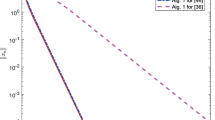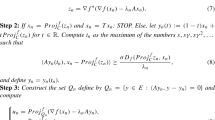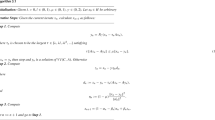Abstract
We propose a new projection-type method with inertial extrapolation for solving pseudo-monotone and Lipschitz continuous variational inequalities in Hilbert spaces. The proposed method does not require the knowledge of the Lipschitz constant as well as the sequential weak continuity of the corresponding operator. We introduce a self-adaptive procedure, which generates dynamic step-sizes converging to a positive constant. It is proved that the sequence generated by the proposed method converges weakly to a solution of the considered variational inequality with the nonasymptotic O(1/n) convergence rate. Moreover, the linear convergence is established under strong pseudo-monotonicity and Lipschitz continuity assumptions. Numerical a exmples for solving a class of Nash–Cournot oligopolistic market equilibrium model and a network equilibrium flow problem are given illustrating the efficiency of the proposed method.




Similar content being viewed by others
Data Availability
The datasets generated during and/or analysed during the current study are available from the corresponding author on reasonable request.
References
Antipin AS (1976) On a method for convex programs using a symmetrical modification of the Lagrange function. Ekonomika I Mat Metody 12:1164–1173
Alvarez F, Attouch H (2001) An inertial proximal method for maximal monotone operators via discretization of a nonlinear oscillator with damping. Set-Valued Anal 9:3–11
Attouch H, Goudon X, Redont P (2000) The heavy ball with friction. I. The continuous dynamical system. Commun Contemp Math 2:1–34
Attouch H, Czarnecki MO (2002) Asymptotic control and stabilization of nonlinear oscillators with non-isolated equilibria. J Diff Equ 179:278–310
Avriel M, Diewert WE, Schaible S, Zang I (2010) Generalized concavity. Society for Industrial and Applied Mathematics
Boţ RI, Csetnek ER, Vuong PT (2020) The forward-backward-forward method from continuous and discrete perspective for pseudo-monotone variational inequalities in Hilbert spaces. Eur J Oper Res 287:49–60
Cai XJ, Gu GY, He BS (2014) On the \(O(1/t)\) convergence rate of the projection and contraction methods for variational inequalities with Lipschitz continuous monotone operators. Comput Optim Appl 57:339–363
Cottle RW, Yao JC (1992) Pseudo-monotone complementarity problems in Hilbert space. J Optim Theory Appl 75:281–295
Dong QL, Cho YJ, Zhong LL, Rassias Th M (2018) Inertial projection and contraction algorithms for variational inequalities. J Glob Optim 70:687–704
Duc PM, Muu LD, Quy NV (2016) Solution-existence and algorithms with their convergence rate for strongly pseudomonotone equilibrium problems. Pacific J Optim 12:833–845
El Farouq N (2001) Pseudomonotone variational inequalities: convergence of the auxiliary problem method. J Optim Theory Appl 111:305–326
Facchinei F, Pang J-S (2003) Finite-dimensional variational inequalities and complementarity problems, vols I and II. Springer-Verlag, New York
Fichera G (1963) Sul problema elastostatico di Signorini con ambigue condizioni al contorno. Atti Accad Naz Lincei VIII. Ser, Rend, Cl Sci Fis Mat Nat 34:138–142
Goebel K, Reich S (1984) Uniform convexity, hyperbolic geometry, and nonexpansive mappings. Marcel Dekker, New York
Harker PT (1984) A variational inequality approach for the determination of oligopolistic market equilibrium. Math Program 30:105–111
Hai TN (2019) On gradient projection methods for strongly pseudomonotone variational inequalities without Lipschitz continuity. Optim Lett 14:1177–1191
He BS (1997) A class of projection and contraction methods for monotone variational inequalities. Appl Math Optim 35:69–76
Hieu DV, Cho YJ, Xiao Y, Kumam P (2020) Relaxed extragradient algorithm for solving pseudomonotone variational inequalities in Hilbert spaces. Optimization 69:2279–2304
Hieu DV, Thong DV (2018) New extragradient-like algorithms for strongly pseudomonotone variational inequalities. J Glob Optim 70:385–399
Karamardian S, Schaible S (1990) Seven kinds of monotone maps. J Optim Theory Appl 66:37–46
Khanh PD, Vuong PT (2014) Modified projection method for strongly pseudomonotone variational inequalities. J Glob Optim 58:341–350
Khanh PD (2016) A new extragradient method for strongly pseudomonotone variational inequalities. Numer Funct Anal Optim 37:1131–1143
Kinderlehrer D, Stampacchia G (1980) An introduction to variational inequalities and their applications. Academic Press, New York
Kim DS, Vuong PT, Khanh PD (2016) Qualitative properties of strongly pseudomonotone variational inequalities. Optim Lett 10:1669–1679
Liu H, Yang J (2020) Weak convergence of iterative methods for solving quasimonotone variational inequalities. Comput Optim Appl 77:491–508
Maingé PE (2008) Regularized and inertial algorithms for common fixed points of nonlinear operators. J Math Anal Appl 34:876–887
Mastroeni G, Pappalardo M (2004) A variational model for equilibrium problems in a traffic network. RAIRO Oper Res 38:3–12
Murphy FH, Sherali HD, Soyster AL (1982) A mathematical programming approach for determining oligopolistic market equilibrium. Math Program 24:92–106
Nagurney A, Zhang D (1996) Projected dynamical systems and variational inequalities with applications. Kluwer Academic
Opial Z (1967) Weak convergence of the sequence of successive approximations for nonexpansive mappings. Bull Amer Math Soc 73:591–597
Ortega JM, Rheinboldt WC (1970) Iterative Solution of nonlinear equations in several variables. Academic Press, New York
Polyak BT (1964) Some methods of speeding up the convergence of iterarive methods. Zh Vychisl Mat Mat Fiz 4:1–17
Reich S, Thong DV, Cholamjiak P, Long LV (2021) Inertial projection-type methods for solving pseudomonotone variational inequality problems in Hilbert space. Numer Algor. https://doi.org/10.1007/s11075-020-01058-6
Stampacchia G (1964) Formes bilineaires coercitives sur les ensembles convexes. C R Acad Sci 258:4413–4416
Sun DF (1996) A class of iterative methods for solving nonlinear projection equations. J Optim Theory Appl 91:123–140
Shehu S, Iyiola OS, Yao JC (2021) New projection methods with inertial steps for variational inequalities. Optimization. https://doi.org/10.1080/02331934.2021.1964079
Thong DV, Gibali A, Staudigl M, Vuong PT (2021) Computing dynamic user equilibrium on large-scale networks without knowing global parameters. Netw Spat Econ 21:735–768
Thong DV, Hieu DV (2018) Inertial extragradient algorithms for strongly pseudomonotone variational inequalities. J Comput Appl Math 341:80–98
Thong DV, Vuong PT (2019) Modified Tseng’s extragradient methods for solving pseudo-monotone variational inequalities. Optimization 68:2207–2226
Thong DV, Vuong PT (2022) R-linear convergence analysis of inertial extragradient algorithms for strongly pseudo-monotone variational inequalities. J Comput Appl Math 406:114003
Vuong PT (2019) The global exponential stability of a dynamical system for solving variational inequalities. Netw Spat Econ. https://doi.org/10.1007/s11067-019-09457-6
Vuong PT (2018) On the weak convergence of the extragradient method for solving pseudo-monotone variational inequalities. J Optim Theory Appl 176:399–409
Vuong PT, Shehu Y (2019) Convergence of an extragradient-type method for variational inequality with applications to optimal control problems. Numer Algor 81:269–291
Yang J, Liu H (2018) A modified projected gradient method for monotone variational inequalities. J Optim Theory Appl 179:197–211
Acknowledgements
The authors are grateful to the Editors and the anonymous referees for their constructive comments, which helped improve the presentation of this paper.
Author information
Authors and Affiliations
Corresponding author
Ethics declarations
Conflicts of Interest
The authors declare that they have no conflict of interest.
Additional information
Publisher’s Note
Springer Nature remains neutral with regard to jurisdictional claims in published maps and institutional affiliations.
Rights and permissions
About this article
Cite this article
Thong, D.V., Vuong, P.T., Anh, P.K. et al. A New Projection-type Method with Nondecreasing Adaptive Step-sizes for Pseudo-monotone Variational Inequalities. Netw Spat Econ 22, 803–829 (2022). https://doi.org/10.1007/s11067-022-09568-7
Accepted:
Published:
Issue Date:
DOI: https://doi.org/10.1007/s11067-022-09568-7




